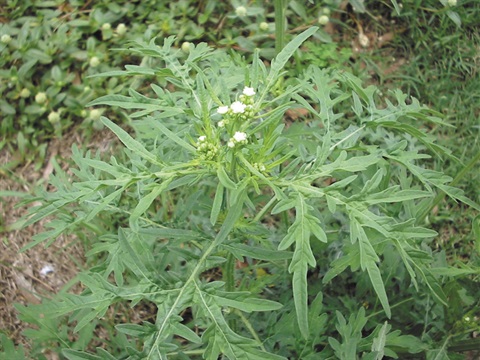Weed of the Week: Parthenium Weed
Published on 07 October 2022

Snowy Monaro Regional Council is calling on all community members to get to know our region’s weeds so we can all play our part in protecting our environment, helping our farmers and supporting our community.
The impact of weeds on our community can be devastating and is estimated to cost the NSW economy about $1.8 billion annually (NSW Department of Industry, 2018).
This is the second article in our Weed of the Week series, where we’ll be sharing information on our region’s priority weeds, this week focusing on Parthenium Weed (Parthenium hysterophorus).
What is Parthenium Weed?
Parthenium Weed is a Weed of National Significance and classified as prohibited matter in NSW. If you see this plant you must report it to either Council on 1300 345 345 or the NSW DPI Biosecurity Helpline on 1800 680 244. Due to the seriousness of this weed, if it is detected on your land you will be provided with the necessary resources to eliminate it.
Parthenium weed is a fast-growing, annual herb with distinctive, small white flowers. It can cause significant allergic reactions, dermatitis, hay fever and asthma in humans and is a serious agricultural weed.
Parthenium weed is a serious pasture invader in Queensland, where it has become well established. While sporadic incursions into NSW occur from plant and machinery movements and the movement of fodder, it has not become established within this State and significant resources are invested into maintaining the status quo. The NSW Biosecurity Act imposes strict border restrictions on the movement of machinery, and in particular harvesting equipment from Queensland and it imposes harsh penalties on those who do not report the incidence of this weed or do not take necessary action to eliminate it from their land.
Why is Parthenium Weed a problem?
- Grows quickly
- Outcompetes other plants by competing for nutrients and moisture and by releasing chemicals into the soil that inhibit growth
- Can cause serious human health problems
- Unpalatable to stock
- Outcompetes degraded or drought-affected pastures
- Reduces carrying capacity
- Causes livestock health problems
- Competes with crop seedlings including sunflowers and sorghum
- Reduces crop yields
- Contaminates grain
- Is a host for crop viruses
Parthenium Weed can cause respiratory problems and severe dermatitis. Do not touch the plant with bare hands and use a dust mask if working near the weed. People might not have an allergic reaction the first time they touch a plant, but allergies can develop after a few exposures. Once a reaction to Parthenium Weed develops, some people go on to develop allergies to related plants such as sunflowers. This reaction can be so severe that people with the allergy may need to move away from Parthenium Weed infested areas.
Livestock do not usually eat Parthenium Weed but if no other feed is available they may eat large amounts. This can cause kidney damage in ruminants (cattle, sheep and goats). Young cattle are most susceptible to dying from Parthenium Weed poisoning. Animals may also have allergic reactions including dermatitis. If livestock (especially sheep) eat Parthenium Weed within one month of slaughter it can taint the flavour of meat. It can also taint milk.
What can you do?
- Learn to identify and report any sighting of Parthenium Weed
- Download the free NSW Weed Wise app onto your phone or visit the website at https://weeds.dpi.nsw.gov.au/
- Call Council and one of our Biosecurity Officers can assist you with identification. If Parthenium Weed is positively identified, Council will initiate an emergency response and resources will be made immediately available to assist you in your eradication efforts.
- Do not attempt to treat or dispose of Parthenium Weed yourself
- Check high-risk sites where Parthenium Weed might establish. These are places with disturbed, degraded or bare soil
- Also, check for it where:
- onew soil or compost has been delivered
- hay, grain or birdseed has been fed to livestock (including chickens)
- Visit Council’s website to understand how we can help you with weed management: https://www.snowymonaro.nsw.gov.au/140/Biosecurity-and-Weeds
- Visit the Department of Primary Industries (DPI) website for information on weed control methods: https://www.dpi.nsw.gov.au/biosecurity/weeds/weed-control
Download the free NSW WeedWise app for detailed information on how to identify and manage local priority weeds. Visit www.dpi.nsw.gov.au/biosecurity/weeds
Visit Council’s website to understand how we can help you with weed management. www.snowymonaro.nsw.gov.au/Environment-Waste-and-Weeds/Biosecurity-and-Weeds
Visit the Department of Primary Industries (DPI) website for information on weed control methods – www.dpi.nsw.gov.au/biosecurity/weeds/weed-control
Contact Snowy Monaro Regional Council if you have any questions regarding weeds on your property or in your neighbourhood. Call 1300 345 345 to be connected to our Biosecurity Officers who specialise in weed management.